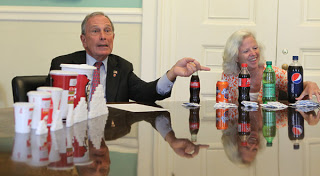NYC deeply split on Bloomberg plan to ban supersize sodas

 |
| Bloomberg with Linda I. Gibbs, deputy mayor for health. (New York Times photo by Chang W. Lee) |
In a bold move to curb obesity, New York City Mayor Michael Bloomberg wants to ban the sale of supersize sodas and other sugary drinks by restaurants, movie theaters and street carts.
“The sale of any cup or bottle of sweetened drink larger than 16 fluid ounces — about the size of a medium coffee, and smaller than a common soda bottle — would be prohibited under the first-of-the-nation plan, which could take effect as soon as next March,” reports Michael Grynbaum for The New York Times.
Exempt from the measure are diet sodas, fruit juice, dairy-based drinks and alcoholic drinks. The ban would include drinks sold in grocery or convenience stores.
“New York City is not about wringing your hands; it’s about doing something,” Bloomberg said. “I think that’s what the public wants the mayor to do.” In NYC, more than half of adults are obese or overweight.
A poll conducted Sunday showed about half of New Yorkers feel Bloomberg is going too far, while 42 percent said it would be good health policy, reports Samantha Gross for The Associated Press. The idea has been harshly criticized, with an editorial in the Times calling the plan “overreaching” and saying “Too much nannying with a ban might well cause people to tune out.”
But conservative David Frum, a contributing editor for Newsweek and The Daily Beast, said “good for Bloomberg,” pointing out: “Sugary drinks now provide 7 percent of the calories in the American diet, the largest single national source of calories. Teen boys average more than a quart of sugary soda per day. Even adults who say they are trying to lose weight still drink more two 12-ounces cans per day, on average.”
“The campaign against obesity will have to look a lot less like the campaign against smoking (which involves just one decision, to smoke or not to smoke) and much more like the generation-long campaign against highway fatalities, which required the redesign of cars, the redesign of highways, and changes in personal behavior like seat-belt use and drunk driving,” Frum argues.